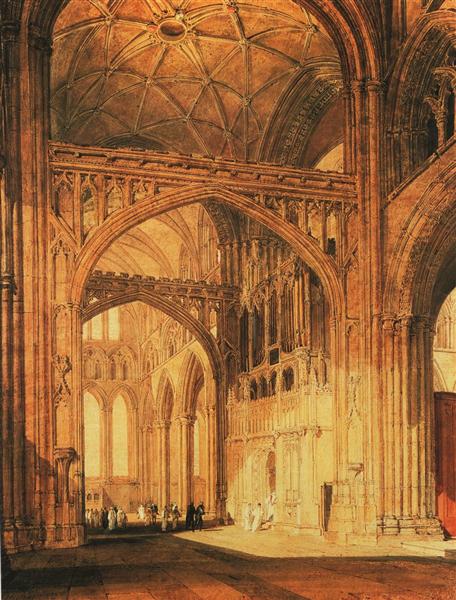ARTH101 Study Guide
Unit 6: Architecture
6a. Explain how the form of architecture affects the use of a structure
- What impacts the ways that works of architecture are built and how they appear?
- What are typical human functions for architecture to support?
- What have been some of the main technologies that influenced architectural style?
Since buildings serve to support human functions, their forms will call forth different approaches to the design of structure. Cathedrals, for instance, required tall ceilings to maximize outside light penetrating the interior spaces in order to create a heavenly presence, which in turn required new inventions like vaulted ceilings and flying buttresses. Central transportation stations built with iron trusses and skylights could accommodate many tracks and trains for the thousands of passengers who used them on a daily basis, and whose new, busier lives involved a need for more frequent travel between cities. The forms of architecture typically serve the functions asked of it, and designers seek out the optimal structures that ultimately support the function as well.
To review, read Methods and Materials.
6b. Describe traditional and modern styles of architecture and the effects of the Industrial Revolution on architecture
- What are some ways that architecture changed when comparing structures built before and after the Industrial Revolution?
- What were some of the main techniques for making buildings before the Industrial Revolution?
- What were some of the main technologies introduced by the Industrial Revolution?
The Industrial Revolution brought with it the ability to mass produce components for buildings, including new possibilities for steel-based frames and concrete which could radically increase the scale of built structures. Such buildings are inherently of a different kind from those built out of stone or wood and assembled with much less technological apparatus. Steel and reinforced concrete meant that spans could be larger, loads could be heavier, and more forceful stresses withstood. It also meant that traditional styles of ornament and decoration were often deemed unsuitable by contemporary architects and designers, who wanted to full embrace the new materials and methods and not stay tied to forms based on much earlier technologies.
To review, read Architecture and the Industrial Revolution.
6c. Explain how architecture acts as a reflection of culture
- What are some examples of buildings that show influences from different cultures?
- What are some examples of buildings that have features that can be traced to a cultural factor?
- What were some of the ways that the cultural interests of architecture changed in the 20th century, as was manifest in various styles?
When we travel to other countries, it is hard not to notice how buildings change so much, based simply on our having relocated ourselves geographically. The different buildings we see across the world in different social contexts point to the varied cultural backdrops against which these buildings were created. While general functions might be similar – for worship, military defense, education, work, or housing – the uniqueness of cultures means that architecture will find unique forms that are well-suited to the cultural environment and which distinguishes these forms from those produced elsewhere.
Example:
Modernist architects rejected the use of ornament and decorative elements based on past historical styles. Rather, they wanted to embrace contemporary materials and methods and create a style dissociated from the past and which addressed the present. A popular Modernist idea was that homes should be like "machines for living".

A form such as the cathedral was based on the idea of creating a great sense of height and letting in lots of colorful light in order to provoke spiritual contemplation and awe. Here the form's aesthetics is grounded in Christian practices of worship and in Catholicism in particular (relative to later Protestant movements), religious buildings were meant to possess a sensual grandeur to inspire the faithful and create a strong sense of ceremony.

To review, read Cross-Cultural Influences on Architecture.
6d. Describe how new "green" technologies are changing architecture and design
- What are the main kinds of building systems and functions addressed by sustainable technologies in architecture?
- What are some of the main technologies used in green architecture?
- What examples can you think of which are good examples of green design in architecture?
All buildings are systems. We might think of them as 'structures' or 'offices' or 'homes,' but they support human functions through assembling together multiple specific functions that address a variety of different human needs. Typical systems which make up a building include heating, cooling, lighting, ventilating, and powering, and might also include other systems such as recycling rainwater, or supporting a living roof. Each of these systems has associated with it methods and technologies that can be traced back to the very origins of architecture. However, most of these systems would be considered as unsustainable in today's more ecologically-informed era. Green or sustainable design looks at new ways to provide the same kinds of traditional building systems with new approaches that minimize harmful environmental impacts.
To review, read Green Architecture.
Unit 6 Vocabulary
Be sure you understand these terms as you study for the final exam. Try to think of the reason why each term is included.
- forms
- functions
- Industrial Revolution
- cultural environment
- modernist architects
- aesthetics
- green/sustainable design